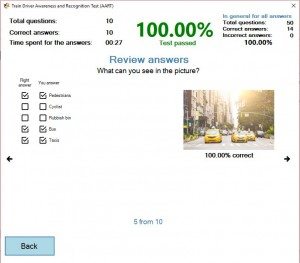
Statistics prove that one of the top 10 most sought after careers after leaving school and full-time education is that of a train driver.
Unsurprising then, that there are in excess of 400 applicants for every job that is advertised. This makes it even more prevalent for the aspiring trainee train driver applicant to have a thorough knowledge of the assessment day and what they will be expected to do, once there.
In this article we will provide you with the essential top 7 tips to passing the train driver assessment day. These will go a long way in helping you gain the highest grades and scores possible during each element of the train driver assessment centre.
To begin with, let’s take a look at the key areas of selection criteria you will be assessed against during the day:
TRAIN DRIVER ASSESSMENT DAY SELECTION CRITERIA
The selection criteria are set by the Rail Safety Standards Board (RSSB). The purpose of the RSSB, amongst other things, is to set Railway Group Standards that should be adhered to within the Rail Industry, including recruitment of trainee train drivers.
The RSSB will work with other sectors of the rail industry to provide a cost-effective and efficient means for delivering a railway service, and the safety standards that the service must adhere to. As we are all aware, safety is absolutely critical to the effective operation of all train operating companies.
The Rail Industry has determined that the following areas will now form part of the selection criteria for the recruitment of train drivers:

ATTENTION: Assessed by way of the Test for Everyday Attention (TEA-OCC)
VIGILANCE: Testing process includes the use of the WAFV
MEMORY & REASONING: A form of selection test that focuses on your ability to train by following rules and procedures (Part 1 and 2)
PERCEPTION: The Adaptive Tachistoscopic Traffic Test (ATAVT) is the assessment format used during this stage of the assessment day.
REACTION TIME: Both the WAFV and ATAVT are used as part of the selection criteria to assess your reaction speed potential.
HAND COORDINATION: 2HAND coordination tools are now used for this part of the assessment day.
COMMUNICATION: Both the Multimodal Interview (MMI) and the Written Communication Test (WCT) are used by the assessors to check your ability to communicate both verbally and in written format.
RELEVANT BEHAVIOURAL/PERSONALITY ATTRIBUTES: The Situational Judgement Test and again, the Multimodal Interview (MMI) are used here to check your performance.
So, now that we have a little bit of an understanding as to the selection criteria for the train driver assessment day, let’s move on to the top 7 tips for success:
TIP NUMBER 1: Practice lots of psychometric tests prior to the day

Remember, you will only get two attempts to pass the train driver assessment, so make sure you are fully prepared.
Whilst it is not uncommon for people to fail the test the first time of trying, it is important that you give yourself every chance of success by trying different forms of assessment before you go to the TOC train assessment day.
Tests such as group bourdon test, WAFV, Vigilance tests, memory tests and also preparing your answers to the interview questions will all help improve performance on the day.
TIP NUMBER 2: Eat and drink healthily in the 4 weeks leading up to the assessment day
DO NOT underestimate how effective this tip can be! If you currently drink alcohol and eat your fair share of junk food, chances are you will not be at your peak. We guarantee that, if you quit alcohol in the build up to your test, and if you eat healthily by cutting out all junk food, your scores WILL improve. The reason for this is because it has been proven that clarity and focus will help dramatically improve psychometric testing scores all round. If you cut out alcohol and junk food, clarity and focus will drastically increase.
TIP NUMBER 3: Understand the Train Driver Assessment Day Scoring Criteria
 The assessors will be primarily looking at your performance on the day. They will not be overly concerned at this stage whether or not you are a good fit for the Train Operating Company; this will come during the Train Driver Manager interview. On that basis, you need to gain the highest scores possible whilst not sacrificing accuracy. Basically, you will lose marks for inaccurate answers and/or guesswork. Therefore, do not be put off if you do not finish a particular test.
The assessors will be primarily looking at your performance on the day. They will not be overly concerned at this stage whether or not you are a good fit for the Train Operating Company; this will come during the Train Driver Manager interview. On that basis, you need to gain the highest scores possible whilst not sacrificing accuracy. Basically, you will lose marks for inaccurate answers and/or guesswork. Therefore, do not be put off if you do not finish a particular test.
Virtually all of the train driver tests are virtually impossible to complete in the given time-frame.
TIP NUMBER 4: The Train Driver Tests Pass Mark
The truth is, nobody, other than the RSSB and the actual creators of each test, knows what the pass mark is. Therefore, do not waste your time searching the Internet trying to find out what it is. Your time will be better spent practicing mock tests and preparing your answers to the interview questions.
In addition to the above, there is also no actual ‘pass mark’, but rather a ‘cut-off point’. The RSSB allegedly set a minimum cut-off that it recommended all Train Operating Companies and assessors use. Extensive research found that, if a candidate falls below the minimum cut-off then he or she will most probably not have the aptitude to become a safe train driver.
TIP NUMBER 5: Work to improve your Oral Communication Skills
The Multi-Modal Interview (MMI) has been specifically designed to assess a candidate’s ability in the area of oral communication. It is not designed to assess your written capabilities; this will be assessed during the Written Communication Test (WCT). The main reason for this is simply because written skills are not deemed as being safety critical within the Rail Industry for Train Drivers, whereas oral communication is.
On that basis, your oral communication skills need to be:
- Concise
- Clear
- Audible
- Relevant
- Succinct
TIP NUMBER 6: The Practice Materials the TOC send you WILL be different to the actual test

Bear in mind that, the standard of test the TOC will send to you prior to the assessment day, will be different to the tests you will undertake on the actual day itself. Therefore, make sure you practice a wide variety of train driver tests, all of which are available from this website.
TIP NUMBER 7: The Written Communication Test (WCT) is Not a PASS or FAIL!
There is no pass or fail mark, or a minimum cut-off for that matter, for the Written Communication Test. Whilst this is good news, it does mean that discretion on who passes or fails this part of the process is entirely down to the assessor.
The test itself will identify your particular strengths and weaknesses in the area of written communication. Remember that, written skills are not deemed safety critical for the role of a train driver. On that basis, if your written skills are not that great, you can still pass based on your scores in the rest of the combined assessments during the assessment day.

